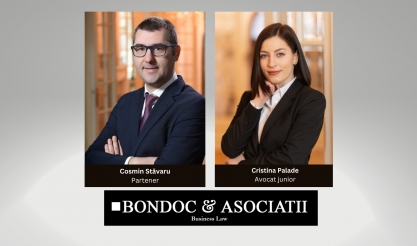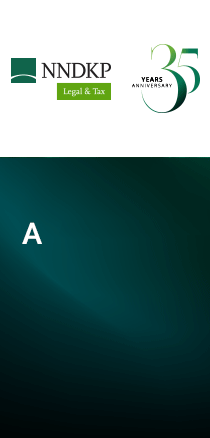
New rules to simplify urban planning and construction permitting
27 Mai 2025 Cosmin Stăvaru (Partener) și Cristina Palade (Avocat junior) - Bondoc & Asociații
Overall, the Ordinance represents a significant step towards simplifying and clarifying the urban planning and building permitting procedures.

|
On April 30, 2025, Government Emergency Ordinance No. 31/2025 on measures to simplify urban planning and construction permitting and to accelerate investment was published in the Official Gazette of Romania and has entered into force (hereinafter referred to as “Ordinance”).
The Ordinance amends the following laws: (i) Law No. 350/2001 on territorial development and urban planning („Law 350/2001”) and (ii) Law No. 50/1991 on the authorization of construction works („Law 50/1991”), as detailed below.
1. Context and purpose
The stated purpose of the Ordinance, as per its underlying explanatory note (the “Explanatory Note”) is to speed up and simplify the current complex, lengthy and costly processes for the approval of urban development plans and for obtaining building permits, which pose significant hurdles / difficulties to investors.
According to the Explanatory Note, the Ordinance is meant to tap into the full potential of the construction sector by reducing administrative burdens, stimulating investments and accelerating the development of projects and to ensure compliance with the pressing deadlines set out under the National Resilience and Recovery Plan (“NRRP”).
2. Simplification of permitting procedures
2.1 Clear deadlines
One of the most important reforms brought by the Ordinance is the standardization and clarification of the permit issuance process through the introduction of precise and overarching time limits for the issuance of endorsements (in Romanian: avize) and approvals (in Romanian: acorduri), namely:
- maximum 30 days from the submission of the application, for the urban planning procedure; and
- maximum 15 days from the submission of the application, for the building permit procedure.
A maximum 15-day time limit, starting from the examination of the documentation by the technical committee for spatial and urban planning has also been introduced for the issuance of the opportunity endorsement (in Romanian: avizul de oportunitate).
The Ordinance introduces a number of derogations from the deadlines set out above (mainly with respect to the starting point of the terms) for the endorsements/approvals o be obtained from: (i) environmental protection authorities (maximum 15 days after the completion of specific environmental procedures); (ii) authorities for the protection of historical monuments (maximum 30 days after the review of the documentation); (iii) central public authorities whose legally established procedure involves a review by a specialized commission (within a maximum of 15 days after the commission examines the documentation);(iv) county emergency inspectorates (maximum 15 days from the submission of the documentation); (v) Romanian Civil Aviation Authority (maximum 30 days from the submission of the documentation).
Also, as a novelty, the beneficiary and the designers must be notified about the date when the documentation will be examined by the relevant committees, regardless of whether they are entitled to attend the meeting or not.
The introduction of clear deadlines for the issuance of endorsements and approvals is an essential step towards ensuring predictability and streamlining the approval of urban planning documentation and construction permitting.
2.2 Extension of validity of the endorsements and approvals for the urban planning documentation
The Ordinance stipulates that the endorsements and approvals issued for urban planning documentation under the same permitting procedure shall remain valid until the approval of the documentation in question, regardless of the deadlines established by the issuing authorities under internal procedures.
Regarding the building permit documentation, Law 50/1991 already provided, even before the issuance of the Ordinance, that the prior endorsements and approvals in force at the time of the building permit application shall remain valid until the date when the building permit is issued and subsequently, until completion of works. This is expressly restated in the Ordinance.
2.3 Concurrent and independent applications for all endorsements and approvals
The Ordinance introduces a prohibition (applicable both to urban planning documentation and building permit) according to which the issuance of endorsements or approvals may not be conditional upon the prior procurement of other endorsements or approvals, except for the opportunity endorsement and the opinion of the chief architect in the case of spatial planning and urban planning documents.
Also, the Ordinance provides that the endorsements and approvals are to be simultaneously applied for from all competent authorities, thus eliminating the practice of sequential approval.
For urban planning documentation, the Ordinance further imposes three other prohibitions, namely:
(i) any requirement for documents or information that goes beyond the specific sectoral substantiation studies and the framework content of the documentation;
(ii) the imposition of requirements or solutions that are not related to the regulatory object or to the degree of detail of the information specific to the respective type of documentation;
(iii) the imposition of multiple taxes or tariffs during the approval process for a PUZ or PUD applied for by private beneficiaries.
The introduction of these new rules may be the result of lessons learned from years of bureaucratic practice, as previously sequential approval chains have often led to delays. By allowing the concurrent fulfilment of procedures, the Ordinance acknowledges the need for a more pragmatic and time-efficient approach.
2.4 A single request for amendment/supplementation/clarification
If, following the analysis of the submitted documentation, clarifications or amendments are deemed necessary, the relevant authorities may request the amendment/clarification/supplementation of the permitting documentation (for both urban planning and construction permitting) only once.
Requests to amend, clarify or supplement the urban planning documentation, may be made only once.
Additionally, a 60-day deadline after the date of receipt of the aforementioned notice has been introduced for the applicant to submit its response.
After receiving the requested amendments/clarifications/supplementations from the applicant, the relevant authorities must (i) issue the approval within 15 days from the submission of the amendments/clarifications/supplementations by the applicant; (ii) reject the documentation.
3. Tacit approval
3.1 Rule
It is worth mentioning that the jurisprudence before the issuance of the Ordinance considered that “the tacit approval procedure is not applicable in the case of building permits, urban planning certificates and urban planning documents…" .
As such, the Ordinance expressly regulates the tacit approval of prior endorsements and approvals in the urban planning and building permit process where the relevant authority does not (i) issue the endorsement/approval or the request for amendment/clarification/supplementation, or (ii) denies the application with justification (in Romanian: justificat). This latter situation opens the possibility of the interpretation that the tacit approval procedure remains applicable in the event the denial is not justified.
This new tacit approval procedure sets forth that if prior endorsements and approvals (or requests for clarifications or application denials) are not issued within the new legal deadlines set forth under the Ordinance, the relevant endorsements and approvals shall automatically be deemed to have been issued (i.e., pursuant to the tacit approval mechanism).
In this case, the applicant may continue the permitting process based on an (i) affidavit stating the lack of reaction from the relevant authority, a template of such affidavit having already been approved and/or (ii) proof of submission of the answer to the request for amendment/clarification/supplementation of the documentation, or the revised documentation, if the case. Endorsements and approvals issued after the applicant has invoked the tacit approval shall not produce legal effects.
The tacit approval procedure should (i) minimize the risk of investments being stalled by administrative inactivity and, at the same time, (ii) not compromise project quality, since issuing authorities may still require the necessary remedial measures during the process to ensure compliance with legislation - it is only their passivity that is being sanctioned, (iii) not exempt the beneficiary, designers and construction entrepreneurs from the obligation to comply with all applicable legislation and to make all necessary efforts to identify the information necessary for the design and execution after the start of the construction works.
3.2 Exemptions and limitations
The Ordinance lays down two exemptions from the tacit approval procedure, more specifically for (i) documentation submitted for approval to the institutions of the National Defence, Public Order and National Security System, and (ii) opportunity endorsements required during the PUZ approval process.
However, it is worth mentioning that the general procedure for confirming tacit approval is regulated by Government Emergency Ordinance No. 27/2003 (which ultimately requires a court ruling to acknowledge/validate the tacit approval) and the Ordinance does not expressly derogate from it. However, it is reasonable to consider that such derogation is implicit by the fact that the Ordinance itself sets out a procedure which is different and autonomous (as well a lot simpler) and given that the stated purpose of the Ordinance is to simplify and speed up the permitting process.
It is also worth mentioning that while the Ordinance has a broad scope of application, it also has, to a certain extent, a limitative coverage, as it is confined to the endorsements and approvals governed by Law 350/2001 and Law 50/1991. Thus, a question would be, for instance, whether the Ordinance also applies to the procedure of removal of land from agricultural circuit governed by Land law No. 18/1991 and ancillary legislation which expressly state that the latter is a distinct procedure which is not part of the building permit procedure under Law 50/1991.
4. Prioritization principle
The Ordinance introduces a double prioritisation principle for projects financed from NRRP and for complex projects.
Thus, the relevant authorities have the obligation to (i) analyse and approve with priority and urgency the documentation for the investments financed from the NRRP; and (ii) prioritize the projects submitted for approval according to their complexity (irrespective of the financing source).
Prioritizing projects according to complexity has the potential to speed up the approval of major projects. We note, however, that the Ordinance does not provide criteria for assessing the complexity mentioned under point (ii) above and unlike in the case of projects financed from NRRP, the wording is less precise (“prioritise” versus “analyse and approve with priority”).
5. Implementation provisions
To ensure procedural continuity and optimize the approval/authorization processes, the person in charge of the file during the analysis and approval process must remain unchanged.
Also, new sanctions (fines ranging from RON 3,000 to RON 10,000, which is rather a small value) have been introduced for failure to comply with some of the obligations incumbent on the relevant authorities, including certain mandatory deadlines (e.g., failure to comply with the 30-day deadline for the introduction on the committee's agenda of the documentation for the issuance of the opportunity endorsement, unjustified rejections of opinions and agreements on technical, scientific and legal grounds, etc.).
Last but not least, the Ordinance includes certain transitory provisions. Thus, the Ordinance shall also apply to the ongoing urban planning and building permitting procedures, as follows: (i) the endorsements and approvals already obtained shall remain valid (this is expressly provided only for the urban planning procedure but should also apply for the building permit procedure according to the general principle of law tempus regit actum); and (ii) for the endorsements and approvals already applied for, but which have not been issued yet, in which case the new deadlines shall be applied from the enactment of the Ordinance (i.e. April 30, 2025).
6. Conclusions
Overall, the Ordinance represents a significant step towards simplifying and clarifying the urban planning and building permitting procedures.
The introduction of the tacit approval mechanism (in a simplified form) stands out as a key instrument for increasing predictability in the permitting process by ensuring continuity in cases of bureaucratic passivity.
Other key benefits include shorter and enforceable deadlines, the possibility to concurrently submit applications for all necessary endorsements rather than sequentially and measures to ensure efficient communication in the case of amendment/supplementation/clarification requests.
Ultimately, the long-term impact of the Ordinance will depend on the final form of the Ordinance ratified by the Parliament and on how the changes will be implemented in the administrative practice of the relevant authorities.
| Publicitate pe BizLawyer? |
  |
| Articol 85 / 4589 | Următorul articol |
| Publicitate pe BizLawyer? |
 |

BREAKING NEWS
ESENTIAL
Piața de Real Estate, radiografiată de NNDKP, firmă despre care ghidurile juridice internaționale spun că este “probabil cea mai bună din România” în această practică: industrial-logistic în viteză, office cu accent pe retenție și eficiență, rezidențial cu presiune pe preț | De vorbă cu Vlad Tănase (partener) despre dinamica pieței, apetitul investitorilor, tranzacționarea proiectelor și blocajele de pe acest segment
Biroul Kinstellar din București a fost alături de Repono AB în achiziția unui sistem de stocare pe bază de baterii în județul Argeș | Karim Nils Grueber (CEO Repono): ”Echipa Kinstellar a fost un partener excepțional pe parcursul acestei tranzacții. Expertiza lor în sectorul energetic, abordarea pragmatică și capacitatea de a răspunde rapid și eficient au fost esențiale pentru a ne ghida prin reglementările complexe ale României”
Bondoc și Asociații, consultanții vânzătorilor in tranzacția prin care Mplus, verticala de BPTO a grupului croat Bosqar, a preluat Valoris Center. Echipa, coordonată de Monica Iancu (partener) și și Gabriela Pop (managing counsel)
Bohâlțeanu și Asociații a asistat Microfruits SA în achiziționarea pachetului majoritar de acțiuni emise de Armătura SA, cu o echipă coordonată de Ionuț Bohâlțeanu (Managing Partner) | Proiectul a presupus o analiză juridică amplă și o coordonare atentă între toate părțile implicate
ITR World Tax 2026 | Brandurile din avocatura locală cu o activitate notabilă în domeniul taxelor urcă în top. NNDKP, CMS, PNSA, TZA, Schoenherr, Băncilă, Diaconu și Asociații, Mușat & Asociații sau Popescu & Asociații, printre cele mai bune firme locale evidențiate pe palierele de General corporate tax, Transfer pricing și Tax controversy
Baciu Partners și coordonatoarea sa au urcat pe primul loc pe podium la gala inaugurală Legal 500 - CEE Awards | Ana-Maria Baciu, după ce a primit distincția „Romania Lawyer of the Year”, iar BACIU PARTNERS a fost desemnată „CEE IP Firm of the Year”: ”Încrederea nu se câștigă printr-o conjunctură, ci prin consistență, prezență și prin convingerea că lucrurile pot fi mereu făcute altfel, în beneficiul direct al echipei și clienților. Standardul pe care îl impune este clar: să livrezi claritate și rigoare în permanență și să ai curajul să gândești diferit, înțelegând miza reală”
Legal500 a desemnat Clifford Chance Badea drept Casa de Avocatură a Anului în România în 2025 | Daniel Badea, Managing Partner: Premiile primite încununează aproape 20 de ani de excelență profesională, de-a lungul cărora ne-am consolidat poziția de lider pe piața de avocatură din România și din regiune, câștigând în paralel aprecierea întregii rețele globale Clifford Chance
LegiTeam: Zamfirescu Racoţi Vasile & Partners recrutează avocat definitiv Achiziții & Corporate| Consultanță
D&B David și Baias confirmă reziliența M&A: achiziții strategice dominante, mecanisme flexibile, grafic de lucru modelat de conformare și componenta tehnică. Echipa livrează soluții prompte în proiecte cu arhitectură complexă, aliniind interesele vânzătorilor cu obiectivele investitorilor și orchestrând integrarea post-closing | Anda Rojanschi (Partener): „Tranzacția de succes este aceea în care cele două afaceri se integrează după finalizarea deal-ului”. O regulă care devine rutină operațională prin rigoare, colaborare și coordonare interdisciplinară
Schoenherr lansează a cincea ediție a concursului de eseuri „law, sweet law‟, cu premii totale de 21.000 lei
Filip & Company a asistat ACP Credit în acordarea unei investiții de capital grupului Dental Elite Clinics. Alexandra Manciulea (partener) și Rebecca Marina (counsel) au coordonat echipa
ZRVP aniversează în 2025 trei decenii de avocatură | Cosmin Vasile, Managing Partner: “Am crescut organic, am construit fără grabă și fără artificii, și am ajuns aici pentru că am rămas fideli profesiei și valorilor ei. Rămânem, după 30 de ani, cu aceleași ținte primordiale: perfecțiunea juridică și formarea de avocați care să ne împărtășească pasiunea, valorile și viziunea”
Citeste pe SeeNews Digital Network
-
BizBanker
-
BizLeader
- in curand...
-
SeeNews
in curand...











 RSS
RSS














































